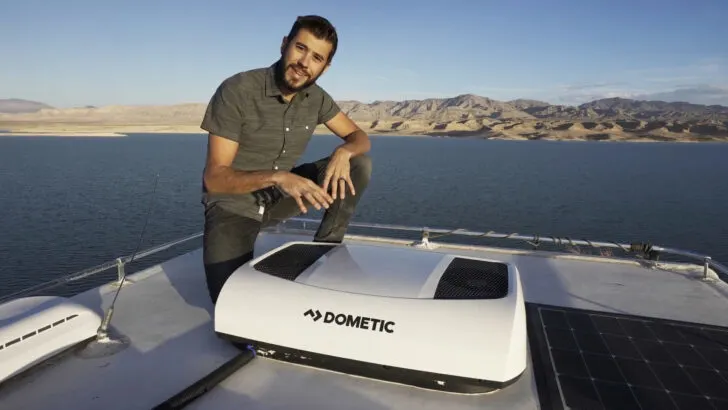Air conditioning is a big concern for RVers, especially in the summer months. For people who like to camp off the grid as we do, the ability to fire up an air conditioner is a luxury we enjoy no matter how far off in the boonies we may be. But, how do you run a power-hungry appliance like an AC unit when you’re camping in the middle of nowhere? That’s a challenge even with our ultimate RV solar panel system. If only there were 12V RV air conditioners.
Firing up a generator to run the AC is one way to deal with hot weather, but that option is ill-suited to the peace some RVers head to the boonies seeking. Traveling in areas where the climate isn’t oppressive is another way to beat the heat. But neither a generator nor a travel schedule created to chase weather is ideal… or always possible.
As it turns out, 12V air conditioners are a thing. Or are they just a cool concept with the promise of becoming a thing?
Let’s shake down the subject of 12V air conditioners to find out!
- 1) How Does a Typical RV Air Conditioner Work?
- 2) What Is a 12V RV Air Conditioner?
- 3) What Are the Advantages of a 12V RV Air Conditioner?
- 4) What Are the Disadvantages of a 12V RV Air Conditioner?
- 5) Are There Any 12V RV Air Conditioners Currently On the Market?
- 6) Would You Be Interested in a 12V RV Air Conditioner?
How Does a Typical RV Air Conditioner Work?
A typical RV air conditioner runs on a 120V power supply. This means that in order to use the appliance, an RVer must either be connected to shore power, be running a generator, or have a battery bank and an inverter capable of handling the power requirements (a huge solar system that can re-charge or offset the huge power draw doesn’t hurt, either).
The problem with being connected to shore power is that it’s highly restrictive to those of us who prefer to boondock.
The problem with running a generator is noise and exhaust (as well as fuel use).
And the problem with using our solar system, battery bank, and inverter is that running an air conditioner consumes HUGE amounts of power… and while staying cool is nice, we have other power needs, too.
We happen to have a couple of AC units/heat pumps on our RV and we’ve upgraded them with Micro-Air EasyStart units that allow us to get more use out of them in certain conditions. In fact, they’ll allow us to run two AC units on a small generator or a 30-amp hookup. We’ll let Peter explain:
But this isn’t the same as having the ability to run an AC unit on battery power. And this is precisely why RVers have long been interested in the development of 12V RV air conditioners.
What Is a 12V RV Air Conditioner?
A 12V air conditioner is literally an air conditioner that only requires 12V electricity to operate. The kind you have available in your onboard battery bank.
Air conditioners that run on 12V DC power are possible thanks to highly-efficient compressors that have been designed to work specifically on 12V current.
What Are the Advantages of a 12V RV Air Conditioner?
With traditional AC units that run on 120V power, the current from a battery bank needs to be transformed from 12V DC to 120V AC power. This conversion is accompanied by up to a 10-15% energy loss. With a 12V air conditioner, that conversion is unnecessary. So, a 12V air conditioner uses less power than a 120V air conditioning unit.
12V AC units can also run while the engine and the generator are OFF (again, assuming you have a sufficiently large battery bank to supply the power). This means that you can run an RV air conditioner on a hot, humid night without having to listen to a noisy generator (or disturb neighbors, if you have any).
What Are the Disadvantages of a 12V RV Air Conditioner?
12V air conditioners suffer their own efficiency losses due to the high current draw. This is because, by necessity, they use very large wires to connect them to the batteries. This alone can cause voltage drops and a loss of efficiency.
Also, due to the high currents involved in a 12V air conditioner, you need a very significant battery bank and would probably need to invest in lithium batteries.
Even when powering your 12V air conditioner from shore power, you’d need a high-current inverter-charger or converter to replace the power being pulled from your batteries. And when your 12V air conditioner is running from shore power, your batteries would be charging very slowly, due to the high current draw of the AC unit.
For all of these reasons, the 12V RV air conditioners currently available are best suited for small RVs.
Are There Any 12V RV Air Conditioners Currently On the Market?
Though they’re not yet widely used, there are a few 12V DC RV air conditioners already on the market.
These air conditioners use high-efficiency compressors and can run completely off of 12V power. Let’s take a look at them now.
Dometic
Dometic’s RTX1000 and RTX2000 12V air conditioning units were developed from a 24V AC unit already commonly used in Europe. Dometic refers to these units as “Truck Air Conditioners”, because they were originally modified for use by truck drivers as parking air conditioners. The intent was to preclude the need for truck drivers to leave their truck engines running for hours on end to keep the cab cool.

Here we’ve brought two photos together to show you a side and front view of a Dometic RTX1000. The RTX2000 has a near-identical appearance. (Photo credits: Dometic)
Known as the “Dometic CoolAir parking coolers”, these truck air conditioners not only save money, truck engine maintenance, and fuel consumption but are also far better for the environment.
Now available on the North American market for use by RVers, the RTX1000 and RTX2000 offer up to 12 hours of running time in Eco mode, their highest efficiency mode consuming only 18A in the RTX1000 and 19A in the RTX2000.
The RTX1000 offers 4,094 BTU (1,200 watts), while the BTX2000 offers 6,824 BTU (2,000 watts). Each has a Turbo mode for faster cooling that requires a higher power consumption.
Dometic notes that its “parking coolers” are suitable for ambient temperatures of 41℉ to 126℉.
All of the AC components are integrated into the roof unit which is short and sleek, sitting only about 6 inches above your roof. The RTX1000 weighs 52.8 lbs while the RTX2000 weighs 72.6 lbs.
Be aware that neither of these units fits into a standard 14” x 14” rooftop opening normally used for RV air conditioners. An internal rooftop opening of 15.5” x 19” is required for the installation of either the Dometic RTX1000 or RTX2000.
Both units require a battery capacity of 180 Ah or better to operate.
Also, note that these units are not heat pumps. They’re intended for cooling only, have a single thermostat zone, and come with remote controls.
The RTX1000 typically retails for $2,700, and the RTX 2000 typically carries a price tag of $3,030.
Nomadic Cooling did an unboxing of the Dometic RTX2000 if you’d be interested in seeing it and hearing about their first impressions:
Nomadic Cooling
Nomadic Cooling offers two 12V air conditioners, the X2 and the X3. (each is also available in 24V or 48V models… we’re focussing on the 12V units here)
The 12V X2 model draws a max of 27A in “Eco” mode and a 55A max in “Max Cool/ Powerful” mode at 85℉. Nomadic Cooling recommends using 4 AWG gauge wire to connect the unit to power.
This is considerably more power consumption than the Dometic unit, but don’t forget it’s also offering a higher cooling capacity of 8,188 BTU (compared to Dometic’s 6,824 BTU), suggesting that it could cool a larger living space. This comes at a significantly higher price, though.
The 12V X2 RV AC model comes at a price of $2,634.95 for the white version. You’ll pay an additional $199 for the Obsidian Black unit.

Here you see the white and black versions of the Nomadic Cooling X2 displayed. (Photo credits: Nomadic Cooling)
Nomadic Cooling’s X3 RV AC model offers a cooling capacity of up to 11,830 BTU.
It draws 50A in “ECO” mode and 110A in “Max Cool/ Powerful” mode. Nomadic Cooling recommends using 2 AWG gauge wire to connect the unit to power.
Nomadic Cooling notes that “ECO” mode should be the default mode of operation, with “Powerful” mode reserved only for short periods of time for maximum cooling (like when initially cooling down an RV that is hot inside).
You’ll be looking at a pretty hefty battery bank to run these units which are powered by DC 12V/24V/48V batteries. Nomadic Cooling says that lithium batteries are preferred, but not mandatory.
Both of these units fit into any new or existing 14” x 14” rooftop opening.
Rigid/Campelify Micro 12V Cooling System
This unit represents a different approach to cooling a small space. It’s essentially a compact refrigeration cooling system kit that includes an R134a mini rotary compressor. It comes as a kit that includes a condenser, driver board, evaporator, fan, heat exchanger, and capillary mini rotary compressor.
The 12V (DC) cooling system uses a type of vapor compression technology to chill the air in a small enclosed space.
With a cooling capacity of only 1,535 BTU (450W) and a maximum power draw of 10A (150W), this system is best suited for very small campers or vans. The manufacturer notes that it will cool a space of approximately 35 cubic feet… which isn’t very much space.
Note that this unit can only cool to about 15-20 degrees below your ambient temperature.
- Maximum cooling temperature the micro dc a/c achieves, 15-20 degree C lower than that of your ambient temperature.It depends on your ambient...
- Rated Voltage: DC 12V; Max Current : 10A; Power:150W; Rated current:1~ 8A,Capacity: 450W (1,535Btu). Micro air conditioner module is a compact...
Indel B
Indel B is an Italian company that offers four different models of 12V air conditioners, but unfortunately they’re not available in North America.
The SW (“Sleeping Well”) Oblo is a parking air conditioner for trucks that provides 3,200 BTU (950 Watts) of cooling and comes in either a 12V or 24V version. It is designed to be a quick installation on the roof hatch of all industrial vehicles.
The SW Aircon 1600 is a 24V DC roof-mounted cab cooler with 5,450 BTU (1,600 Watts) of cooling power.
The SW Cube is a 950W 12V or 24V truck air conditioner that’s portable and can be moved from one cab (or RV) to another. It requires no installation and no holes cut in the walls or rooftop. It’s a stand-alone unit that’s designed to sit in the cab, with its aeration hoses set in a window.
The trouble with these intriguing units that are unavailable in North America is that they’re – well – unavailable in North America. So, no matter how intriguing they may be, if you can’t get your hands on one, it won’t help to cool your rig.
We recently took a look at the Truma Aventa, and the same issue applies there. The unit looks great – but it’s only available on a few select new RVs. If there’s nothing on the aftermarket, we’re hard-pressed to be able to become consumers of these products.
Perhaps in time.
Would You Be Interested in a 12V RV Air Conditioner?
So, what do you think of the idea of a 12V RV air conditioner, and how do you feel about the development of the technology to date? Would you be interested in a 12V AC unit for your rig? Drop us a comment and let us know!
Meanwhile, check out our troubleshooting post if your existing RV AC is not cooling well.
Geek Out With Us Every Week
Join our newsletter to learn about all things RV-related. Every week we offer free tips, tricks, product reviews, and more to our online community of RVers. So, whether this is your first time on the road or you’re a seasoned expert, we’d love for you to geek out with us!



mike
Friday 29th of March 2024
Do you have any experience with the Rec-Pro 48v units
Gary
Monday 4th of December 2023
I have a 40'coach with 1800 watts of solar ideal conditions and 720 amp hrs Expion lithium. We are from Ontario Canada and only come south in the winter. We require more heating than cooling on average.
Why can't these A/C manufacturers add a reversing valve and make it an inverter heat pump??? Aislu Electric in China make 15,000 BTU inverter R/V rooftop heat pump 120 VAC, which I would go with. I have emailed them several times with no response. I have purchased other items direct from China on a small scale with no great effort.
Maybe you can get their attention purchasing on a larger scale?
Thanks, Gary.
Peter Kingsley
Friday 31st of March 2023
I have a 12 volt AC in my rig and it's not one of those you've listed. It's from Cruise N Comfort, a small company based in Phoenix.
The model I have is their HD-12L model, which produces 8000 BTU. This is adequate for my rig which has double-glazed windows and 60mm thick insulated walls.
The reason I went with it is because I wanted no roof-mounted AC; my preference being with maximum solar on the roof and to maintain a lower profile.
The unit is located under one side of the dinette, with ducting going to the ceiling. The condenser is mounted under the body behind the rear wheels.
I'm very happy with it and it's comforting to know the manufacturer is down the road from me.
TheRVgeeks
Friday 31st of March 2023
Sounds like a great setup, Peter. We'll have to look more into Cruise N Comfort systems.
Stuart Bell
Tuesday 25th of October 2022
Have you looked at the Mabru 12 volt roof a/c. At 12 kBtu/hr it would meet my cooling needs. It claims to be very, very quiet and highly efficient. The specs are impressive, any real life experience?
TheRVgeeks
Thursday 27th of October 2022
Hi Stuart... no, haven't seen that unit. We'll have to take a look! Sounds interesting!
DUTCH Van Atlanta
Sunday 11th of September 2022
I have the ProAir 12 VDC A/C unit on a 24 ft Sprinter upfit. It does OK, but most definitely is not the 20k BTU that the manufacturer claims.
DUTCH Van Atlanta
Monday 12th of September 2022
@DUTCH Van Atlanta,
It is also screechy noisy on the outside, although there is an after market condenser fan available that quiets it down some.
It also draws 90-100 Amps in 90°-100° weather.